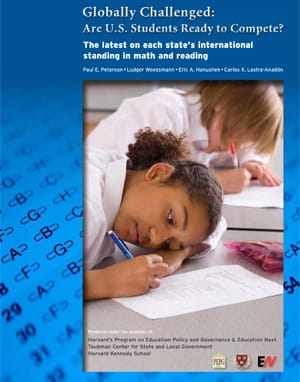 Last November, Harvard’s Program on Education
Policy and Governance (PEPG) teamed up with Education
Next to assess how well American states fare at getting their students to advanced levels in mathematics compared
to their international peers. (Hint:
not so well.) Continuing this line of work, this new PEPG/Ed Next report analyzes how successful
states are at lifting their students to proficient
levels—this time for both math and reading. To do so, Paul Peterson, Ludgar
Woessman, Eric Hanushek, and Carlos Lastra-Anadon performed a crosswalk between
NAEP and PISA results for math and reading for the Class of 2011 (a
representative sample of which took both the eighth-grade NAEP in 2007 and the
fifteen-year-old PISA in 2009). And the findings aren’t any more promising: In
terms of math proficiency, the U.S. average puts us on par with Iceland, Italy,
and Spain. Our worst states, Alabama and New Mexico, rank below Turkey and just
ahead of Bulgaria and Serbia. Similar results are found with reading. The
report goes on to explain that America’s lackluster results aren’t just about
our achievement gap; even U.S. white students don’t command international
acclaim—they are surpassed (in terms of percent proficient) by students from
sixteen countries in math and eight countries in reading. Going further, the
research team determined that the U.S. could enjoy staggering bumps in its
annual GDP growth per capita by enhancing the math proficiency of its
students—we’re talking $75 trillion over twenty years (which is roughly five
times our current GDP). The debt-ceiling super-commission might want to take a
look.
Last November, Harvard’s Program on Education
Policy and Governance (PEPG) teamed up with Education
Next to assess how well American states fare at getting their students to advanced levels in mathematics compared
to their international peers. (Hint:
not so well.) Continuing this line of work, this new PEPG/Ed Next report analyzes how successful
states are at lifting their students to proficient
levels—this time for both math and reading. To do so, Paul Peterson, Ludgar
Woessman, Eric Hanushek, and Carlos Lastra-Anadon performed a crosswalk between
NAEP and PISA results for math and reading for the Class of 2011 (a
representative sample of which took both the eighth-grade NAEP in 2007 and the
fifteen-year-old PISA in 2009). And the findings aren’t any more promising: In
terms of math proficiency, the U.S. average puts us on par with Iceland, Italy,
and Spain. Our worst states, Alabama and New Mexico, rank below Turkey and just
ahead of Bulgaria and Serbia. Similar results are found with reading. The
report goes on to explain that America’s lackluster results aren’t just about
our achievement gap; even U.S. white students don’t command international
acclaim—they are surpassed (in terms of percent proficient) by students from
sixteen countries in math and eight countries in reading. Going further, the
research team determined that the U.S. could enjoy staggering bumps in its
annual GDP growth per capita by enhancing the math proficiency of its
students—we’re talking $75 trillion over twenty years (which is roughly five
times our current GDP). The debt-ceiling super-commission might want to take a
look.
|
Paul E. Peterson, Ludgar Woessman, Eric A. Hanushek, and Carlos X. Lastra-Anadon, “Globally Challenged: Are U.S. Students Ready to Compete?,” (Cambridge, MA: Harvard University Program on Education Policy and Governance and Education Next, August 2011). |
